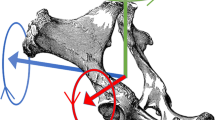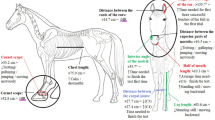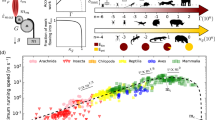Relay riders over two millennia delivered mail with a remarkably consistent alacrity.
Abstract
Express postal systems relied on horses for a period that spanned two millennia (540 BC to AD 1861), and these systems showed remarkable consistency in the average mail-courier speed and in the distance between horse-changing stations. Here I show how this adopted speed and distance combination was ideal for optimal horse performance and can be explained with a modern understanding of equine physiology and with reference to recent endurance records. The parameters of the historical systems were chosen to avoid heat stress deriving from an otherwise over-boosted metabolic machine and to reduce the risk of the animal falling lame.
This is a preview of subscription content, access via your institution
Access options
Subscribe to this journal
Receive 51 print issues and online access
$199.00 per year
only $3.90 per issue
Buy this article
- Purchase on Springer Link
- Instant access to full article PDF
Prices may be subject to local taxes which are calculated during checkout

Similar content being viewed by others
References
Xenophon Cyropaedia Book VIII, 6.17–18.
Gazagnadou, D. La Poste á Relais (Kimé, Paris, 1994).
Hoyt, D. F. & Taylor, C. R. Nature 292, 239–240 (1981).
Minetti, A. E., Ardigò, L. P., Reinach, E. & Saibene, F. J. Exp. Biol. 202, 2329–2338 (1999).
Hanak, J. et al. Acta Vet. Brno 70, 133–139 (2001).
Potard, U. S., Leith, D. E. & Fedde, M. R. J. Appl. Physiol. 84, 2052–2059 (1998).
Saltin, B. in Limiting Factors of Physical Performance (eds Keul, J. & Thieme, G.) 235–252 (Georg Thieme, Stuttgart, 1973).
Snow, D. H. Res. Vet. Sci. 27, 372–378 (1979).
Woledge, R. C., Curtin, N. A. & Homsher, E. Energetic Aspects of Muscle Contraction (Academic, London, 1985).
Snow, D. H., Harris, R. C., MacDonald, I. A., Forster, C. D. & Marlin, D. J. Equine Vet. J. 24, 462–467 (1992).
Rose, R. J. Br. Vet. J. 142, 542–552 (1986).
Foreman, J. H. Vet. Clin. North Am. Equine Pract. 14, 205–219 (1998).
Suetonius The Twelve Caesars Book I, 57.
Author information
Authors and Affiliations
Ethics declarations
Competing interests
The author declares no competing financial interests.
Supplementary information
Rights and permissions
About this article
Cite this article
Minetti, A. Efficiency of equine express postal systems. Nature 426, 785–786 (2003). https://doi.org/10.1038/426785a
Issue Date:
DOI: https://doi.org/10.1038/426785a
This article is cited by
-
The genetics of human performance
Nature Reviews Genetics (2022)
-
Alternative Metabolic Strategies are Employed by Endurance Runners of Different Body Sizes; Implications for Human Evolution
Adaptive Human Behavior and Physiology (2022)
-
Endurance running and the evolution of Homo
Nature (2004)
Comments
By submitting a comment you agree to abide by our Terms and Community Guidelines. If you find something abusive or that does not comply with our terms or guidelines please flag it as inappropriate.



